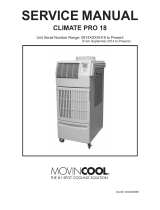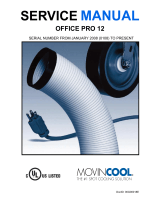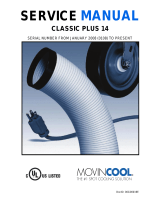
Si181296_A
Removal Procedure 1
Table of Contents
1. Outdoor Unit............................................................................................2
1.1 Outer Panels ............................................................................................2
1.2 PCBs / Electrical Components .................................................................4
1.3 Outdoor Fans / Fan Motors ....................................................................12
1.4 Thermistors ............................................................................................13
1.5 Electronic Expansion Valves / Peripheral Equipments...........................14
1.6 Four Way Valve......................................................................................17
1.7 Compressor............................................................................................18
2. BP Unit ..................................................................................................21
2.1 PCB Assembly .......................................................................................21
2.2 Electronic Expansion Valve Coils...........................................................23
Note: The illustrations may be slightly different depending on the model.
The illustrations are for heat pump models as representative.

Outdoor Unit Si181296_A
2Removal Procedure
1. Outdoor Unit
1.1 Outer Panels
Warning Be sure to wait for 10 minutes or more after turning off all power supplies before
disassembling work.
Step Procedure Points
1
2
3
4
5
6
7
Remove the 8 screws
and remove the top
panel.
Remove the screw of
the front panel (2).
Push the front panel (2)
downward to release
the hook and remove it.
Remove the screw and
remove the piping cover
(front).
Remove the 4 screws
and remove the piping
cover (rear).
Slide the outdoor
temperature thermistor
to the right and detach
it.
Remove the 6 screws
and remove the right
side panel.
It is possible to remove only
the front panel (2) without
removing the top panel.
Top panel
(R12962)
Front panel
(2)
Piping cover
(front)
(R18289)
Outdoor temperature
thermistor
Right side
panel
Piping cover (rear)

Si181296_A Outdoor Unit
Removal Procedure 3
8 The outdoor unit has 2
discharge grilles.
Remove the 4 screws
and unfasten the 4
hooks to remove a
discharge grille.
U.S. model:
The front panel (1) has 2 air
outlet protection nets. To
detach an air outlet
protection net, remove the 4
screws.
9
10
Remove the 7 screws
of the front panel (1).
Push the front panel (1)
upward and remove it.
On the rear side of the front
panel (1), a reinforce plate is
attached. Be careful not to
lose it while removing the
front panel (1).
Step Procedure Points
Discharge
grille
Discharge
grille
Hook
Hook
Hook
Front
panel (1)
(R18960)
Reinforce plate
(R18961)

Outdoor Unit Si181296_A
4Removal Procedure
1.2 PCBs / Electrical Components
Warning Be sure to wait for 10 minutes or more after turning off all power supplies before
disassembling work.
Step Procedure Points
1. Remove the terminal
cover (The U.S. models
only).
M5(2) × 12
1 Remove the screw on
the terminal cover
(upper) and open the
terminal cover (upper).
2 Remove the screw and
open the terminal cover
(lower).
M5(3) × 12
3 Remove the 2 screws
and remove the
terminal covers.
M5(3) × 12
Terminal cover (upper)
Screw
(R18962)
Terminal cover (lower) Screw
Terminal mounting
plate
(R18963)
(R18964)
Screw

Si181296_A Outdoor Unit
Removal Procedure 5
2. Remove the PCBs and
electrical components.
M5(3) × 12
1 Remove the 2 screws
of the terminal
mounting plate.
(Except the U.S.
models.)
2 Remove the screw
above the electrical
component assembly.
M5(3) × 12
3 Unfasten the clamp
from the terminal
mounting plate.
Step Procedure Points
(R12966)
Terminal mounting plate
(R9220)
(R18065)

Si181296_A Outdoor Unit
Removal Procedure 7
6 Disconnect the
connectors [X106A]
[X107A].
[X106A] [X107A]: fan motor
7 Release the fan motor
lead wires from the
hooks.
8 Release the lead wires
of the solenoid valves
and four way valve from
the fixing plate and then
remove the electrical
component assembly.
Step Procedure Points
(R12967)
[X106A] [X107A]
(R9227)
(R9228)

Outdoor Unit Si181296_A
8Removal Procedure
9 Remove the 2 screws
of the insulation sheet
and then release the
compressor lead wires
(blue, red, white) and
the relay wires between
A1P and A3P (red,
blue) from the hooks.
10 Remove the 2 screws
from [LB] (red) and [NB]
(blue) on A3P and
disconnect the 2 lead
wires of condenser
(orange, gray).
M4 × 8 with spring washer
Step Procedure Points
(R9229)
(R9230)
(R12968)
Condenser (C4)
Orange
[NB]
[LB]
Gray

Si181296_A Outdoor Unit
Removal Procedure 9
11
12
Cut the 2 clamps for the
compressor lead wires.
Cut the clamp for the
relay wires from A3P to
A1P (red, blue) and for
the earth / ground
(green).
Clamps (2 places) for the
compressor lead wires
Clamp for the relay wires from A3P to
A1P and for the earth / ground
13 Push and unfasten the
2 hooks and slide the
casing to the right and
remove the casing from
the electrical
component assembly.
Step Procedure Points
(R18980)
(R9233)
(R9234)
(R9235)
Hook

Outdoor Unit Si181296_A
10 Removal Procedure
14 Disconnect the
connectors [X66A]
[X81A] [X5A].
15 Disconnect the reactor
lead wire connectors,
compressor lead wire
connector, and all the
other connectors from
the main PCB.
Step Procedure Points
[X66A] [X81A] [X5A]
(R12970)
[X66A]
[X81A]
[X5A]
[X22A]
[X21A]
[X13A]
[X11A]
[X18A]
[X17A]
[X32A]
[X25A] [X26A] [X27A] [X28A] LD
LE
U
V
W
[X12A]
(R18299)
Compressor lead
wire connector
Reactor lead
wire connectors

Si181296_A Outdoor Unit
Removal Procedure 11
16 Remove the screw at
the top of the electrical
component assembly.
M4(2) × 12
17 Unfasten the 2 hooks at
the rear side.
18 The figures in the right
are PCB assembly.
Step Procedure Points
(R9238)
Hook
(R12972)
Fixing plate for the
PCB
Electrical component
mounting plate
Cool / heat selector
PCB (A4P)
(R12973)
Service PCB
(A2P)
Noise filter PCB
(A3P)
Electrical component
mounting plate
Main PCB (A1P)
(for control)

Outdoor Unit Si181296_A
12 Removal Procedure
1.3 Outdoor Fans / Fan Motors
Warning Be sure to wait for 10 minutes or more after turning off all power supplies before
disassembling work.
Step Procedure Points
1 Remove the nuts and
remove the outdoor
fans.
Nut size : M8
When reassembling, align
the mark of the outdoor
fan with the D-cut section of
the motor shaft.
2 Cut the clamp. Pull out the connector while
supporting the fan motor and
pushing the engaging hook,
without pulling its lead wires.
When reassembling, put the
fan motor lead wire through
the back of the fan motor (so
as not to be entangled with
the outdoor fan).
Be sure to remove the lower
screws first. If the upper
screws are removed first, the
fan motor, the center of
gravity of which is toward the
front, may tilt down or fall,
getting you injured.
3 Remove the 4 screws
and remove the fan
motor.
Outdoor fan
Nut with a washer
(R12974)
13 mm
(0.51 inch)
(R18965)
Earth / ground wire
Clamp
D-cut
(R18515)
Fan
motor
Mount the fan motor with its mark "z"
positioned toward the bottom.
(R3249)
Lead wire Outdoor fan

Si181296_A Outdoor Unit
Removal Procedure 13
1.4 Thermistors
Warning Be sure to wait for 10 minutes or more after turning off all power supplies before
disassembling work.
Step Procedure Points
1 For the details of the
removal of the outdoor
temperature thermistor
(R1T), see the points
on the right column.
Removal of the outdoor
temperature thermistor
(R1T)
When reassembling, pass
the outdoor temperature
thermistor through the hole
so as the yellow marking
comes to the inside edge of
the heat exchanger plate.
2 Pull out the discharge
pipe thermistor (R2T).
3 Pull out the suction pipe
thermistors (R3T)
(R5T).
4 Pull out the subcooling
thermistor (R6T) and
the liquid pipe
thermistor (R7T).
5 Pull out the outdoor
heat exchanger
thermistor (R4T).
Suction pipe thermistor 2 (R5T)
Discharge pipe thermistor (R2T)
(R12975)
Subcooling
thermistor (R6T)
Suction pipe
thermistor 1 (R3T)
Liquid pipe thermistor
(R7T)
Outdoor heat exchanger
thermistor (R4T)
Hooks (2 places)
Right side panel
Notch
Fixing plate for thermistor (R1T)
Stopper
Outdoor temperature thermistor
Marking (yellow)
(R13061)
Removal
direction

Outdoor Unit Si181296_A
14 Removal Procedure
1.5 Electronic Expansion Valves / Peripheral Equipments
Warning Be sure to wait for 10 minutes or more after turning off all power supplies before
disassembling work.
Be careful not to get yourself burnt with the pipes and other parts that are heated by
the gas brazing machine.
If the refrigerant gas leaks during work, ventilate the room. (If the refrigerant gas is
exposed to flames, toxic gas may be generated.)
Caution From the viewpoint of global environment protection, do not discharge the refrigerant
gas in the atmosphere. Make sure to collect all the refrigerant gas.
Cautions for restoration
1. Restore the piping by non-oxidation brazing.
2. It is required to prevent the carbonization of the oil inside the four way valve and the
deterioration of the gaskets affected by heat. (Keep below 120°C (248°F).) For the sake of
this, wrap the four way valve with wet cloth and provide water so that the cloth does not
dry.
Note Before working, make sure that the refrigerant gas is empty in the circuit.
Be sure to apply nitrogen replacement when heating up the brazed part.
Do not use a metal saw for cutting pipes by all means because the sawdust comes into
the circuit.
When withdrawing the pipes, be careful not to pinch them firmly with pliers. The pipes
may get deformed.
Provide a protective sheet or a steel plate so that the brazing flame cannot influence
peripheries.
Be careful so as not to burn the compressor terminals, the name plate, the outdoor
heat exchanger fin.
In case of difficulty with gas brazing machine
1. Disconnect the brazed part where is easy to disconnect and restore.
2. Cut pipes on the main unit with a tube cutter in order to make it easy to disconnect.
Step Procedure Points
1 Pull out the 2 electronic
expansion valve coils.
2 Remove the 2 pressure
sensors.
(R18070)
Electronic
expansion
valve coil
(main)
(Y1E)
Electronic
expansion
valve coil
(subcooling)
(Y3E)
(R12976)
High pressure sensor (S1NPH)

Si181296_A Outdoor Unit
Removal Procedure 15
The pressure sensor is
equipped with a gauge port
with check valve. Therefore,
when loosening the nut,
refrigerant leak stops.
3 Disconnect the lead
wires of the high
pressure switch.
4 Remove the screw and
remove the solenoid
valve coil for hot gas
bypass.
5 Remove the screw and
remove the solenoid
valve coil for unloading.
Step Procedure Points
(R12977)
Low pressure sensor (S1NPL)
High pressure switch (S1PH) (R12978)
(R12979)
Solenoid valve coil for
hot gas bypass (Y2S)
Solenoid valve coil for unloading (Y3S) (R12980)

Outdoor Unit Si181296_A
16 Removal Procedure
6 Heat up and disconnect
the brazed part of the
electronic expansion
valve.
7 Heat up and disconnect
the brazed part of the
high pressure switch.
8 Heat up and disconnect
the brazed parts of the
solenoid valve.
Step Procedure Points
(R12981)
Electronic
expansion valve
(main)
Electronic
expansion valve
(subcooling)
Brazed part High pressure switch (R13062)
(R12983)
Solenoid valve for
hot gas bypass
Solenoid valve for unloading (R12984)

Si181296_A Outdoor Unit
Removal Procedure 17
1.6 Four Way Valve
Warning Be sure to wait for 10 minutes or more after turning off all power supplies before
disassembling work.
Be careful not to get yourself burnt with the pipes and other parts that are heated by
the gas brazing machine.
If the refrigerant gas leaks during work, ventilate the room. (If the refrigerant gas is
exposed to flames, toxic gas may be generated.)
Caution From the viewpoint of global environment protection, do not discharge the refrigerant
gas in the atmosphere. Make sure to collect all the refrigerant gas.
Cautions for restoration
1. Restore the piping by non-oxidation brazing.
2. It is required to prevent the carbonization of the oil inside the four way valve and the
deterioration of the gaskets affected by heat. (Keep below 120°C (248°F).) For the sake of
this, wrap the four way valve with wet cloth and provide water so that the cloth does not dry.
Note Before working, make sure that the refrigerant gas is empty in the circuit.
Be sure to apply nitrogen replacement when heating up the brazed part.
Do not use a metal saw for cutting pipes by all means because the sawdust comes into
the circuit.
When withdrawing the pipes, be careful not to pinch them firmly with pliers. The pipes
may get deformed.
Provide a protective sheet or a steel plate so that the brazing flame cannot influence
peripheries.
Be careful so as not to burn the compressor terminals, the name plate, the outdoor
heat exchanger fin.
In case of difficulty with gas brazing machine
1. Disconnect the brazed part where is easy to disconnect and restore.
2. Cut pipes on the main unit with a tube cutter in order to make it easy to disconnect.
Step Procedure Points
1 Remove the screw and
remove the four way
valve coil.
The cooling only models
have no four way valve.
2 Heat up and disconnect
the brazed part of the
four way valve (A, B, C,
D).
(R9262)
B
A
CD
(R9263)

Outdoor Unit Si181296_A
18 Removal Procedure
1.7 Compressor
Warning Be sure to wait for 10 minutes or more after turning off all power supplies before
disassembling work.
Be careful not to get yourself burnt with the pipes and other parts that are heated by
the gas brazing machine.
If the refrigerant gas leaks during work, ventilate the room. (If the refrigerant gas is
exposed to flames, toxic gas may be generated.)
Since it may happen that the refrigerant oil in the compressor catches fire, prepare wet
cloth so as to extinguish fire immediately.
Caution From the viewpoint of global environment protection, do not discharge the refrigerant
gas in the atmosphere. Make sure to collect all the refrigerant gas.
Cautions for restoration
1. Restore the piping by non-oxidation brazing.
2. It is required to prevent the carbonization of the oil inside the four way valve and the
deterioration of the gaskets affected by heat. (Keep below 120°C (248°F).) For the sake of
this, wrap the four way valve with wet cloth and provide water so that the cloth does not
dry.
Note Before working, make sure that the refrigerant gas is empty in the circuit.
Be sure to apply nitrogen replacement when heating up the brazed part.
Do not use a metal saw for cutting pipes by all means because the sawdust comes into
the circuit.
When withdrawing the pipes, be careful not to pinch them firmly with pliers. The pipes
may get deformed.
Provide a protective sheet or a steel plate so that the brazing flame cannot influence
peripheries.
Be careful so as not to burn the compressor terminals, the name plate, the outdoor
heat exchanger fin.
In case of difficulty with gas brazing machine
1. Disconnect the brazed part where is easy to disconnect and restore.
2. Cut pipes on the main unit with a tube cutter in order to make it easy to disconnect.
Step Procedure Points
1Open upward the sound
insulation for the
terminal cover.
Sound insulation for the terminal cover
(R9264)
Page is loading ...
Page is loading ...
Page is loading ...
Page is loading ...
Page is loading ...
Page is loading ...
Page is loading ...
Page is loading ...
-
 1
1
-
 2
2
-
 3
3
-
 4
4
-
 5
5
-
 6
6
-
 7
7
-
 8
8
-
 9
9
-
 10
10
-
 11
11
-
 12
12
-
 13
13
-
 14
14
-
 15
15
-
 16
16
-
 17
17
-
 18
18
-
 19
19
-
 20
20
-
 21
21
-
 22
22
-
 23
23
-
 24
24
-
 25
25
-
 26
26
-
 27
27
-
 28
28
Daikin RMKS112LV1A User manual
- Type
- User manual
- This manual is also suitable for
Ask a question and I''ll find the answer in the document
Finding information in a document is now easier with AI
Related papers
-
Daikin RMXS160EV1A User manual
-
Daikin BPMKS967A3 User manual
-
Daikin FTK12NMVJU User manual
-
Daikin RKM33NV2S User manual
-
Daikin Altherma HT User manual
-
Daikin Super Multi NX FVXS35FV1B User manual
-
Daikin ARXS50G2V1B User manual
-
Daikin FBQ60B7V1 x 2 User manual
-
Daikin 3MXS68EVMA User manual
-
Daikin VRV III REYQ32PY1 User manual
Other documents
-
Hitachi RAS-(4-12)HNC(1)(E) User manual
-
Hitachi RAS-12-HNPE User manual
-
Hitachi RAS-(4-10)HRNS(2)E User manual
-
Hitachi RAS-10HRNM User manual
-
 Movincool CLIMATE PRO 18 User manual
Movincool CLIMATE PRO 18 User manual
-
York Mini VRF Heat Pump Outdoor Unit Single Phase 208/230V User manual
-
Denso Movincool CLIMATE PRO K60 User manual
-
Movincool CPK36 User manual
-
 Movincool OFFICE PRO 12 User guide
Movincool OFFICE PRO 12 User guide
-
 Movincool CLASSICPLUS14 User manual
Movincool CLASSICPLUS14 User manual

































